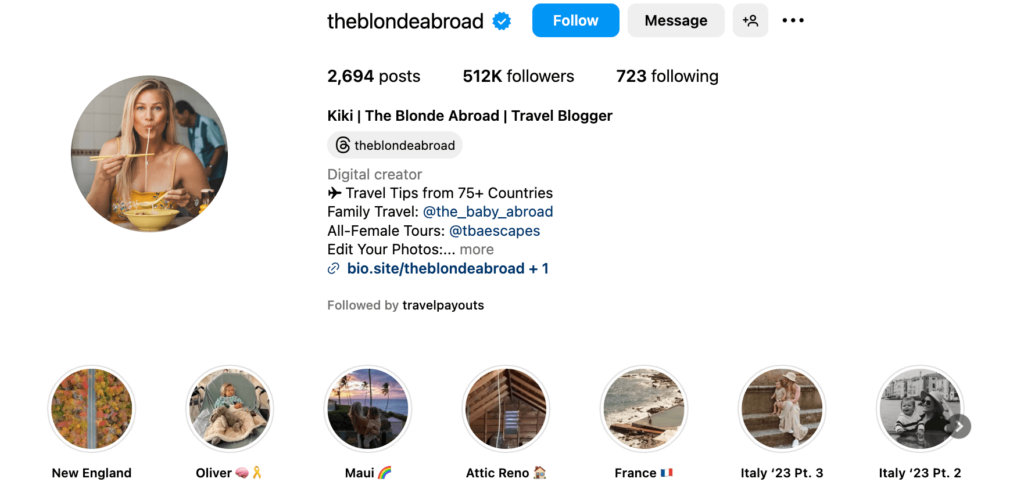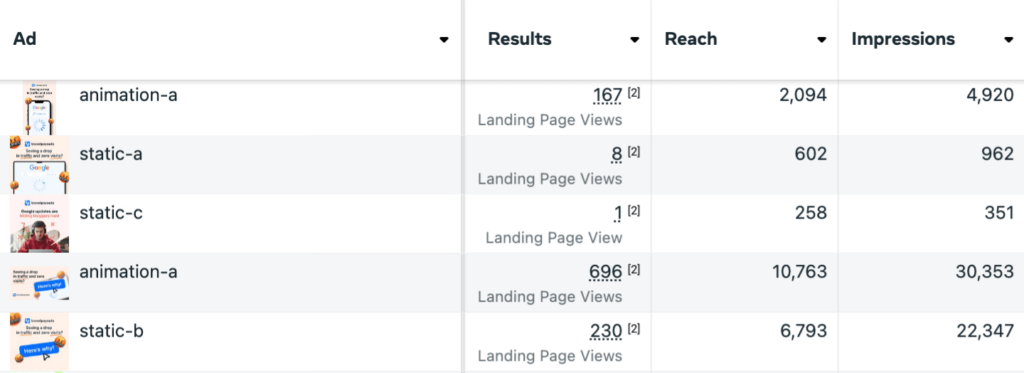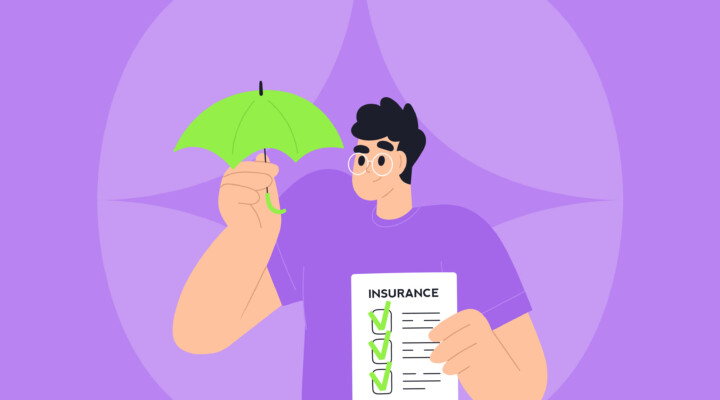Hi! I’m Angelika, a digital marketing expert and travel blogger who’s worked with leading brands in the industry.
This line of work means I’ve become very familiar with Instagram, Facebook, TikTok, YouTube, and other socials. I suggest you do, too; putting all your eggs in Google’s basket is risky, as we’ve seen over the last year.
In this article, I’ll share what I’ve learned about social media marketing to help you boost your business – specifically, how to drive traffic to your website and enhance its visibility.
What is social media traffic?
Social media traffic refers to visitors who land on your website from platforms like Facebook, Instagram, Pinterest, and others.
High social media traffic means your content is reaching the right audience and making them want to know more about you.s
The benefits of using social media to drive traffic
Organic traffic from search engines is a great way to attract readers to your blog for free. But as we know, search algorithms can change at any time.
Social media is a great way to diversify your traffic and provides other benefits, too. For example, it allows for more personal engagement with your followers, fostering community and loyalty. You can also share stories about your recent trips, using visuals, storytelling, and other creative techniques to pique people’s interest.
Choosing the right social media platforms
When choosing a platform, focus on your niche, your audience, and the content you want to create.
For travel bloggers, Instagram and Pinterest tend to be visual and engaging platforms, while Facebook and TikTok are good for content with the potential to go viral.
These articles will help you understand which social networks are worth your time and effort:
In general, though, there are four main steps to choosing the right platform:
1. Research your audience. Start by understanding your readers’ ages, locations, and interests.
If your audience is mostly aged 18-24, TikTok and Instagram may be the most effective. If you’re aiming at older followers, consider Facebook.
Location is another factor to take into account. For example, TikTok shows content mostly to people in the same area as the creator. Instagram and Facebook are better for reaching people in specific locations.
☝️ Use Google Analytics, Facebook Audience Insights, or other analytics tools to find this information.
2. Define your content type. If you enjoy photography, platforms like Instagram and Pinterest are natural choices. If you prefer storytelling or tutorials, YouTube may be the way to go.
Look at The Ginger Wanderlust and Lost LeBlanc – two inspirational Insta-masters 👇


3. Analyze competitors. Look at what successful bloggers in your niche are doing on various platforms.
For example, if you want an example of using stunning visuals and engaging an audience through Instagram Stories, check out The Blonde Abroad. For Facebook, see how Nomadic Matt shares articles and interacts with followers. This analysis can help you identify trends and strategies that resonate with your target audience.

4. Test and adapt. Start by creating content for a couple of platforms and monitor your engagement levels.
For instance, try posting the same content on Instagram and Pinterest or TikTok, and compare engagement metrics like likes, shares, and comments. Based on the results, adjust your strategy to focus on the platforms that yield the best results.
How do you track these metrics, you ask? We’re one step ahead of you – check out our roundup of the best analytics tools 👇
11 ways to drive traffic from social media
So, you’ve decided which social networks suit your needs. How do you actually start using them to your advantage?
1. Optimize for SEO. Ensure your social media profiles are optimized with keywords, clear CTAs (calls to action), and links to your website. SEO-optimized profiles help you rank higher on search engines and attract more visitors.
If you’re a travel blogger, use keywords like “travel tips,” “solo travel,” or “budget travel” in your bio.


An optimized bio for a social media profile might look like this:
🌍 Solo Travel Expert | Sharing Budget Travel Tips & Hidden Gems | ✈️ Follow for Your Next Adventure! | 👉 [link to blog]For more on how to optimize your accounts for SEO, check out this article 👇
2. Create engaging content. It should be informative, shareable, and visually appealing. Use Instagram carousels, YouTube Shorts, TikTok videos, or Pinterest boards and link them back to your articles.
Here are some concrete ways to make content engaging:
- Tell a story. Share personal experiences and memes that resonate with your audience. Storytelling helps create an emotional connection, making your content more shareable.
- Nomadic Matt often writes personal posts that go beyond “travel is fun,” like this one on the question of running away from your problems. This makes his social content relatable.
- Create listicles or how-to guides. Content that provides value, such as “10 Tips for Solo Travel” or “How to Travel on a Budget,” tends to be shared frequently.
- The blog Adventurous Kate features many listicle-style posts that are easy to share, such as “5 Stunning, Offbeat Natural Parks of Québec.”
- Use videos. Short videos or reels on Instagram and TikTok can capture attention quickly. Focus on quick tips or destination highlights.
- Encourage engagement. Ask questions or include polls in your posts to encourage followers to engage with your content. This can create a sense of community and boost visibility and shares.
3. Use hashtags and social proof. Hashtags extend your reach, allowing more potential followers to discover your content.
Social proof, such as reviews, testimonials, and user-generated content, is another good strategy. It’ll build trust with your audience, which is essential for encouraging them to engage with and share your content.
Here are eight proven ways to grow your brand with social proof 👇
4. Promote content across platforms. Make sure you’re cross-promoting relevant content. Post the same blog link on Instagram, Pinterest, and Facebook to broaden its reach.
This doesn’t need to increase your workload – there are tools for managing multiple social media profiles simultaneously, and we’ve put together a list 👇
5. Engage with your audience. Engaging with your followers keeps them coming back. Reply to comments, run Instagram Stories polls, and ask your audience for feedback. Building personal connections will foster loyalty.

6. Collaborate with influencers. Collaborate with influencers or other travel bloggers to expose new audiences to your blog. This can be done through shout-outs, guest posts, or social media takeovers. Partner with micro-influencers to build credibility.
7. Run paid campaigns. Paid ads on platforms like Facebook and Instagram are highly effective at driving targeted traffic to your blog. Recently, Travelpayouts ran a campaign with Facebook Ads that generated a significant increase in blog traffic.

8. Share links in groups and communities. Posting links to your blog in relevant Facebook groups, Reddit forums, or Threads is an organic way to gain visibility. Engage with the community and post content that can truly add value for each community.
Here are some valuable Facebook groups for travel bloggers:
- Women Travel Creators: A supportive community aimed at helping women expand their reach and connect in the travel blogging world.
- Girls LOVE Travel: With over 1.1 million members, this group is also exclusively for women and provides a platform to share experiences and tips.
- Digital Nomads Around the World: This group is for travelers who work remotely and want to share tips and advice on living the digital nomad lifestyle.
- Travel Bloggers Support: A community dedicated to helping travel bloggers promote their content and share insights.
9. Use social media tools. Use tools like Canva for graphics, ManyChat for automating responses, and Google Analytics for tracking traffic. It’ll make managing your social media easier. For more great tools and services, check out our roundup 👇
10. Post consistently and at optimal times. Consistency is key: posting regularly ensures you stay visible in your audience’s feeds.
Here’s a summary of optimal posting practices for various platforms as of 2024:
| Platform | Posting frequency |
| One post per day, five to ten posts per week. Posting more than twice a day can lead to diminished engagement | |
| • Three to seven posts per week • One or two stories per day • Four to seven reels per week | |
| At least one post per week | |
| TikTok | One to four videos per day |
11. Keep up with social media trends. Stay up to date on the latest trends to keep your strategy relevant. If you’ve been paying attention to the travel blogging world, these are the kinds of things you’ll have noticed:
- Short-form videos. For instance, Travelwithtalia showcases travel hacks or unique destinations in short videos that often go viral. This trend reflects the growing preference for concise, engaging content.
- Increased engagement via direct messaging. Many brands are using direct messaging (DM) to create personalized customer interactions. For example, Airbnb answers questions and provides tailored travel recommendations, fostering a deeper connection with its audience.
☝️ You can automate this process using ManyChat. - Longer video content. YouTube is witnessing a resurgence in longer travel vlogs. Creators like Lost LeBlanc produce comprehensive guides that dive deep into destinations, providing detailed itineraries and tips. These in-depth videos appeal to viewers seeking more substantial content.

How to promote your blog on different social media platforms
- Engage with other communities. Share your blog posts in relevant travel groups, engaging with members by asking questions or starting discussions about your content.
- Create a Facebook page. Use it to share updates, travel tips, and blog posts. Posting regularly can help increase your reach and visibility (see the chart above).
- Host live Q&A sessions. Engage your audience in real time by hosting live sessions on travel topics, referring people back to your blog for detailed insights.
- Share stories and posts. Regularly share snippets from your blog. Use engaging visuals and captions that encourage followers to click through to your articles.
- Create reels. Short, engaging videos that highlight your travel experiences can capture people’s attention and get your name in their heads. Use trending audio and relevant hashtags to reach a broader audience.
- Use hashtags strategically. Add keywords related to travel, such as #travelblogger, #wanderlust, and specific destination hashtags to improve visibility and attract organic traffic.
- Create boards for evergreen content. Develop boards that focus on evergreen topics related to your blog, such as “Budget Travel Tips” or “Must-See Destinations.” Pin your blog posts to these boards to increase website traffic.
- Use rich pins. Enhance your pins with additional information, making them more clickable. This can help drive more traffic from Pinterest to your blog.
- Infographics. Create visually appealing infographics summarizing key points from your blog posts. These are highly shareable and can attract links back to your blog.
- Gather travel content. Use Flipboard to create a collection of travel-related articles, including your own blog posts.
- Engage with readers. Respond to comments and engage with readers who interact with your content, fostering relationships that can win your blog new fans.
TikTok
- Use calls to action. For example, mention your blog when discussing a related topic or include a brief text overlay directing viewers to check out your blog for more tips or information.
- Leverage trending hashtags. Use the Discover page or hashtag generators to find popular and niche-specific hashtags that resonate with your content, helping you reach a more engaged audience.
YouTube
- Create video content. Publish travel vlogs or tutorials that complement your blog posts. Include links to your blog in the video description and tell viewers in each video to check out your posts.
- Optimize video titles and descriptions. Use relevant keywords in your video titles and descriptions to improve search visibility and attract more organic traffic.
FAQ
Can I drive traffic from social media without a large following?
Yes, you don’t need a huge following in order to drive traffic to your blog or website using social media. We discussed the most effective strategies earlier in this article.
What content formats work best for driving traffic?
The answer here depends on the social media platform:
- Facebook: Videos, links to blog posts.
- Instagram: Carousels, stories with links to blog posts.
- Pinterest: Pins, video pins.
- TikTok: Short videos, challenges and trends.
- YouTube: Long-form videos, YouTube Shorts.
Which platforms are the most effective for driving traffic?
Flipboard, YouTube, Instagram, Pinterest, and Facebook are generally the top platforms for travel bloggers.
It may seem like a lot of work, but go step by step, platform by platform, and you’ll start to reap the rewards. By optimizing your social media channels, creating engaging content, and staying on top of trends, you can boost your blog’s traffic and build a loyal audience. And keep following the Travelpayouts blog for more tips on optimizing your online presence!




